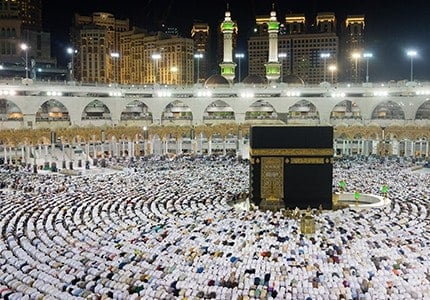Makkah is one of the holiest cities in Islam. It is the birthplace of the Prophet Muhammad (PBUH), who lived here for 52 or 53 years before migrating to Medina. He made a triumphant return here as a conqueror but moved back to Medina.
There are many sacred sites in Makkah, but it is well-known for Kaa’ba, the house of Allah (SWT). Muslims turn to Kaa’ba five times a day to pray. The Hajj is also performed in and around Makkah. Masjid-u-Haram is also located in Makkah, which houses the Kaa’ba.
Makkah remained under the control of different Muslim dynasties in history before Ibn Saud conquered it in 1925. He eventually formed the Kingdom of Saudi Arabia, which remains so to this day.
Makkah has seen tremendous expansion and development in the last thirty years. To accommodate the ever-growing rush of pilgrims, the Saudi government embarked upon an ambitious expansion plan for the Masjid-ul-Haram, and today it can accommodate 2.5 million faithful.

Nowadays, there are high-end luxury hotels, residential towers and a modern road network in Makkah. It is a modern city with a thriving economy and continues to develop rapidly.
Makkah Royal Clock Tower stands tall over the Holy Kaa’ba and is the third tallest building in the world. It provides premium luxury accommodation to those who can afford it.
Some 15 million Muslims visit Makkah annually, which is set to grow. Makkah of today is no longer the sleepy town it once was. It was a hustling bustling city with a voracious appetite to grow and expand further.
Mina is a valley located in the east of the city of Makkah. It is a 5km long valley that comes alive during the Hajj days as pilgrims stay here on the 11th and 12th of Dhul Hajj.
During this time, a tent city pops here as the pilgrims stay in makeshift white tents. These tents have modernized over time and now feature fire-proof materials (to counter fire-catching incidents), air conditioners and other amenities.
The Jamarat Bridge is also located in Mina. It is the stoning of the site, where Muslims symbolically pelt stones at Satan. It was here that Satan tried to dissuade Prophet Ibrahim (AS) from obeying the will of Allah (SWT). The entire area has enormous symbolic value for Muslims, and staying here is part of the obligatory rites of Hajj.

Muzdalifah is between Mina and Arafat and is a flat piece of land. After spending the day at Arafat and listening to the Hajj Sermon, the pilgrims leave for Muzdalifah, where they spend the night in the open.
There is a hill here in Muzdalifah called Mashar-ul-Haram with a mosque. The Prophet (PBUH) advised his followers to pray near Mashar-ul-Haram while facing Qibla.
The pilgrims have an overnight stay here and the following day after Fajr, leave for Mina, where the ritual of Satan-stoning takes place at Jamarat.
Previously there used to be three pillars at Jamarat, representing three sites where Satan came to convince Ibrahim (AS) to give up Allah’s command of sacrificing his son. He shooed away Satan thrice and hit it with pebbles.
The stoning of Satan often resulted in mayhem and stampedes resulting in unfortunate casualties. To counter this, the Saudi government established a one-way bridge making it easier for pilgrims to throw stones at Satan. Three high walls replace the three pillars.

The valley of Arafat or Arafa’ is situated 20 km away from Makkah. All Muslims must gather here on the 9th of Dhul Hajj during Hajj. They spend the day here, supplicating before Allah (SWT) and offering Dhikr and Darood.
The Holy Prophet delivered a sermon here during the only Hajj he performed sitting on his camel, Quswa. That tradition continues, and the Imam delivers the Hajj Sermon here from the Masjid-e-Nimra. Two-thirds of this mosque is in Arafat, while one-third of its part is in the valleys of Nimra and Urana.
After the Hajj Sermon, Muslims offer the combined prayers of Dhur and User, known as Qsr.

The Mount of Mercy, or Jabal-ur-Rahmah, is also located here. It is a 70m high mountain where Prophet Muhammad (PBUH) stayed and made waqoof.
Arafat holds great significance for Muslims and is considered a very holy site. The Prophet Muhammad (PBUH) advised his followers to make dua here on the 9th of Dhul Hajj and termed it an excellent time to offer dua before Allah (SWT) and ask for His forgiveness.
The Prophet Muhammad (PBUH) and his trusted and loyal friend, Abu Bakr (RA), took refuge in this cave while migrating from Makkah to Medina.
His enemies at Makkah were after their lives, and when they hid inside this cave, Allah commanded the spider to spin a web at its entrance. And a pair of doves to make a nest there and lay eggs.
His enemies came to the cave’s mouth and, upon seeing the nest inside and an entire web, concluded that nobody was inside; otherwise, the web must have been broken.
Allah has hinted at this incident in Saurah Tauba. The Prophet (PBUH) and his companion stayed inside the cave for three days. Abu Bakr’s son used to look after them. Once the danger subsided, they moved out and headed for Medina.

AlHadi Travel” ATOL Protected & IATA certified Travel Partner – proudly offers a superior chance to book all inclusive Premium Exclusive Hajj & Umrah Packages Including Flights/Airfare at cheapest price; featuring 5 Star Luxurious Accommodation & Flights Tickets.



Monday to Sunday
09:00 – 17:00